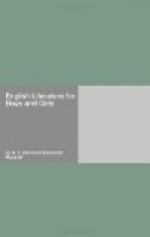In the Journal to Stella we find many entries about this difficulty between the friends, “Mr. Addison and I are as different as black and white, and I believe our friendship will go off by this business of party. But I love him still as much as ever, though we seldom meet.” “All our friendship and dearness are off. We are civil acquaintance, talk words of course, of when we shall meet, and that’s all. Is it not odd?” Then later the first bitterness of difference seems to pass, and Swift tells how he went to Addison’s for supper. “We were very good company, and I yet know no man half so agreeable to me as he is.”
It was while Addison was in Ireland that Richard Steele started a paper called the Tatler. When Addison found out that it was his old friend Dick who had started the Tatler he offered to help. And he helped to such good purpose that Steele says, “I fared like a distressed prince who calls in a powerful neighbour to his aid. I was undone by my own auxiliary; when I had once called him in, I could not subsist without dependence on him.”
This was the beginning of a long literary partnership that has become famous. Never perhaps were two friends more different in character. Yet, says Steele, long after, speaking of himself and Addison, “There never was a more strict friendship than between those gentlemen, nor had they ever any difference but what proceeded from their different way of pursuing the same thing. The one with patience, foresight, and temperate address, always waited and stemmed the torrent; while the other often plunged himself into it, and was as often taken out by the temper of him who stood weeping on the brink for his safety, whom he could not dissuade from leaping into it. . . . When they met they were as unreserved as boys, and talked of the greatest affairs, upon which they saw where they differed, without pressing (what they knew impossible) to convert each other."*
Steele in the Theatre, 12.
The Tatler, like Defoe’s Review, was a leaflet of two or three pages, published three times a week. The Review and other papers of the same kind no doubt prepared the way for the Tatler. But the latter was written with far greater genius, and while the Review is almost forgotten the Tatler is still remembered and still read.
In the first number Steele announced that:—“All accounts of gallantry, pleasure and entertainment, shall be under the article of White’s Chocolate-House; Poetry under that of Wills’ Coffee-House; learning under the title of Grecian; foreign and domestic news you will have from Saint James’s Coffee-House; and what else I have to offer on any other subject shall be dated from my own apartment.”
The coffee-houses and chocolate-houses were the clubs of the day. It was there the wits gathered together to talk, just as in the days of Ben Jonson they gathered at the Mermaid Tavern. And in these still nearly newspaperless days it was in the coffee-houses that the latest news, whether of politics or literature or sheer gossip, was heard and discussed. At one coffee-house chiefly statesmen and politicians would gather, at another poets and wits, and so on. So Steele dated each article from the coffee-house at which the subject of it would most naturally be discussed.




